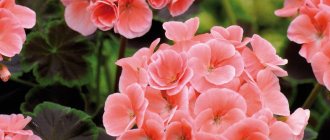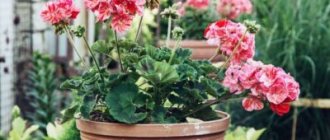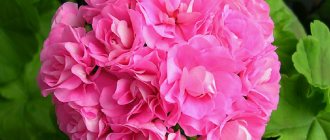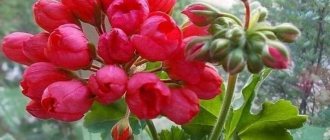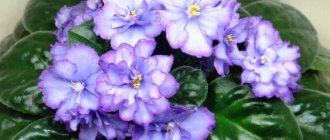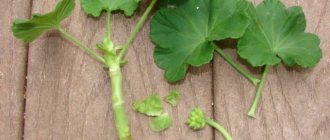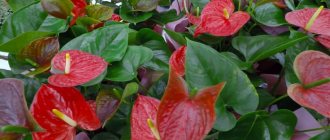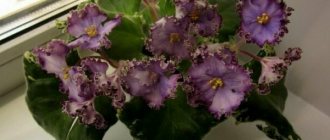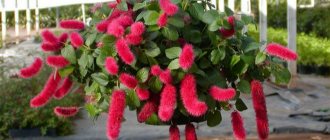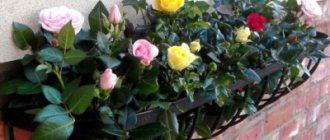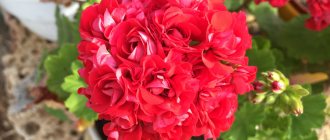The main advantages of these popular garden plants are their striking umbrella-shaped inflorescences and beautiful, often edged or very fragrant leaves. The flowers usually have five petals, of which the top two are often larger than the rest and have contrastingly colored veins. This extensive genus, with a natural range spanning Africa, Australia, the Middle East and Asia Minor, includes mainly subshrubs and herbaceous perennials, preferring open sunny locations and frost-free climates. Although only a few species are widely bred, they come in hundreds of different varieties.
Pelargonium
There are four main and many small groups of pelargoniums.
- Ivy-leaved pelargoniums - with small dense palmate leaves and drooping shoots - are ideal for hanging baskets.
- Royal (large-flowered, English) pelargoniums are distinguished by large bright corollas.
- Fragrant pelargoniums have pinnately incised leaves with a strong, pleasant aroma.
- The leaves of zonal pelargoniums are round, slightly lobed, with a wide contrasting border along the edge or at some distance from it. These pelargoniums are colloquially called geraniums, but should not be confused with plants of the genus Geranium.
There is an additional division of pelargonium varieties, which includes angelic pelargoniums with small two-tone flowers; star-shaped pelargoniums with appropriately shaped corollas; unique pelargoniums with large fragrant flowers. In addition, there are dwarf and miniature plants that are perfect for decorative vases and window boxes.
All pelargoniums can be grown in containers, but many are used as bedding annuals. Most bloom all summer and until early autumn, although the picturesque inflorescences of the royal varieties can only be admired for a few weeks in mid-summer.
Varieties of the Salmon group
The Salmon group is represented by a wide variety of varieties, among which you can find both zonal and royal pelargoniums.
Quinn
A delightful zonal geranium worthy of any queen. Among the bright green foliage with dark chocolate-colored edging, lush caps of simple flowers of light peach color with a bright salmon-colored star-shaped center look stunning.
Plant height is up to 35 cm. The flower is grown in summer in flower beds and on balconies.
Comtesse
This zonal hybrid variety is the achievement of German breeders, whose task was to develop beautiful and unpretentious varieties for landscaping squares and parks. The uniqueness of the plant is that it can survive frosts down to -7 degrees, which is completely unusual for African sissies. The variety blooms profusely and is very easy to care for.
The bush is compact, very graceful, about 35 cm high. The leaves of the plant are velvety, dark green. The inflorescences of double flowers are large, collected in rich clusters. Lush pink caps look very impressive against the background of the dark greenery of the bush.
Knight
A popular variety of perennial pelargonium. Voluminous and compact bushes 35 cm high, 25 cm in diameter. This unique variety has brown leaves with a thin green edging along the edge. Salmon-colored flowers form large spherical inflorescences.
With proper care, the plant can bloom all year round. Over the course of the season, each crop forms about 50-60 inflorescences. The variety is popular both among amateurs and professional flower growers.
Princesses
The amazingly beautiful representative of the pelargonium “Salmon” is distinguished by a very lush compact bush of medium size. The spherical inflorescences consist of large semi-double flowers of a soft creamy color, with a pinkish tint in the middle.
The number of flowers on a peduncle varies from 8 to 10 pieces. Under the weight of the lush caps, the flower stalks will elegantly bend down. The variety is perfect for decorating balconies and terraces in the summer.
Bulls Eye
This geranium is designed for professional cultivation. It will adequately decorate the terraces of prestigious cafes and restaurants, flower beds of large public institutions on the central streets of cities. It has dense elastic leaves. Bright pink large ball-inflorescences on low fleshy peduncles reach 15 cm in diameter. The height of the plant is almost 40 cm. The stems are powerful, large, and are not afraid of bad weather.
The variety looks very presentable in tall powerful flowerpots. The plant grows voluminous and lush. You can plant it in a home flower garden, in a spacious, well-lit place where there will be no direct burning rays of the sun.
Mephisto F1 Salmon
A wonderful professional zonal variety. Height – 35 cm. The shoots are strong, branch well, forming a beautiful spreading bush. The leaves of the plant are round, chocolate-colored, with a bright green edge and an elegant wavy edge. The inflorescences are dense, uniform, and come in various colors:
- Mephisto F1 Scarlet – juicy red inflorescences;
- Mephisto F1 Rose - rich pink-lilac flowers.
Inspire
A universal variety of geranium that grows well indoors and in flower beds, looks great on balconies and loggias. Flowering is bright and abundant all summer. Inflorescences of juicy salmon color are collected in spherical inflorescences up to 10 cm in diameter.
Plant height is 25-30 cm. The bush has a beautiful compact shape and is very easy to care for. The variety tolerates drought well, is tolerant of short-term cold snaps, and can bloom beautifully in partial shade.
Nano
Baby Nano Salmon F1, barely appearing on the market, managed to win the hearts of pelargonium fans. This is a new variety of dwarf pelargonium, which surprised everyone with its generous flowering against the background of rich decorative greenery.
The bush is so compact, and there are so many flowering inflorescences that they look like a fluffy blanket of juicy pink color. The flowers of the plant are simple in shape, but huge in size, the size of a matchbox.
The height of the bush is only 25 cm, and it does not require growth stimulants. This geranium is intended for indoor growing under normal conditions.
Aristo Salmon F1
This is a delightful royal pelargonium with early and long flowering. The flowers of the plant are funnel-shaped, with wide and long apricot-colored petals, with a crimson streak at the base. Geraniums are found in white, crimson, violet and purple colors, with or without spots at the base.
The foliage of the plant is very exquisite, lush and carved, with a peculiar smell. The plant blooms from May to September. Geranium "Aristo" is demanding on growing conditions. With the onset of autumn, pelargonium needs cool, bright apartments to continue flowering.
Quantum Salmon F1
A star-shaped zonal geranium with lush foliage with a serrated edge. Flowers in the shape of small stars are collected in spherical inflorescences on tall peduncles reminiscent of carnations.
The height of the bush is up to 40 cm. The flowering is long-lasting and generous. The plant loves spacious tall flowerpots, in which it looks impressive outdoors, in massive landscape compositions.
Angels
Low varieties with medium-sized, appressed, crenate-edged leaves and “angelic faces” of flowers reminiscent of pansies. But they are called angels after the first variety of the miniature royal series, “Angeline,” which was later used in hybridization. Due to the fact that curly pelargonium (Pelargonium crispum) was included in the hybridization of this group of varieties, some angels inherited fragrant foliage from it. Angels bloom from August to late summer, but the abundance of flowers decreases as autumn approaches. They do not need cold wintering.
| Pelargonium angel PAC Angeleyes Viola |
- RAS Angeleyes Burgundy – one of the Angelyes Series “Pacviola” varieties with dark purple-red upper petals and the same spot on the lower petals, with a burgundy network of veins;
- RAS Angeleyes Viola is another variety from the Angelyes Series “Pacviola”. It blooms very profusely with medium-sized pink flowers with a crimson spot (larger on the upper petals). The foliage has a citrus aroma.
|
|
- Darmsden - up to 30 cm in height, with small rounded leaves, the upper petals are cherry-pink with a dark burgundy spot, the lower petals are white, with a lavender-pink tint.
- Imperial Butterfly - up to 30 cm tall, white flowers with magenta feathers on the upper petals. The foliage is scentless, but the flowers have a faint lemon scent.
| Pelargonium angel Tip Top Duet |
- Spanish Angel - up to 30 cm tall, flowers up to 3.5 cm in diameter, upper petals are dark red, almost black, with bright fringed edges, lower petals are pale lilac, with purple feather-shaped markings.
- Tip Top Duet - up to 35 cm in height, with rounded leaves, the upper petals are wine red with pink edges, the lower petals are pale pink with purple veins.
Landing rules
It is advisable to plant this beauty in mid-April or early May, when the soil is already well warmed up. Before planting, it is advisable to rub large Salmon pelargonium seeds a little with fine sandpaper.
High-quality planting material can be purchased in specialized stores.
- To plant, you need to fill a wooden box with nutritious soil.
- Then make grooves at a distance of 2-3 cm.
- Place the seeds every 1.5 cm, lowering them to a depth of 1 cm. The plantings do not have to be sprinkled with soil; it is enough to cover them with film.
- Sprouts will appear in 14-20 days. After they have formed 2 leaves, they can be transplanted into containers with a diameter of no more than 10 cm.
- Pour the soil to the edges of the pot, and make a depression in the center.
Pelargonium is a light-loving plant, so choose sunny places for planting.
The flower tolerates heat, drought and cold well. It is advisable to feed with fertilizers with a low nitrogen content. The plant does not need careful care, but hypothermia, lack of light and moisture can provoke bacterial wilt.
Make sure there is no stagnation of water and waterlogging of the soil. Remove dried flowers promptly.
Lighting
Homemade Salmon geraniums should be placed on south, south-east and south-west windows. Flowers must be protected from the scorching sun with light curtains.
In winter, if you want to extend the flowering period, you need to provide the plant with lighting. Well-lit places and partial shade are suitable for outdoor bushes.
The soil
"Salmon" prefers loose, breathable soil with low acidity and moderate nutrition.
The substrate must include:
- peat;
- sand;
- humus;
- agroperlite;
- leaf soil.
Plants need good drainage so that moisture does not stagnate in the ground.
Growing
Keep container pelargoniums in 15 cm diameter pots with good drainage in a frost-free location in the sun.
Water abundantly in summer, sparingly in winter. Replant in the spring, approximately every 2 years. Remove spent flowers and leaves regularly.
Plant flowerbed pelargoniums in fertile, well-drained soil with a neutral or alkaline reaction when the threat of return frosts has passed, and dig up before the first frosts in the fall. Renew your planting annually. Treat ivy-leaved varieties in hanging baskets in the same way.
What you need to know about care
Caring for Salmon pelargoniums involves implementing standard agrotechnical practices.
Watering
Pelargonium Salmon needs moderate watering. It is advisable to water 1-2 times a week. Excess moisture negatively affects the plant. For irrigation you need to use soft and settled water. If water gets on the leaves and petals, it can cause burns.
Feeding
During the flowering period, plants prefer phosphorus-potassium fertilizers. You can use liquid fertilizers or add a long-acting dry granular fertilizer to the soil when planting. In this case, you will not have to worry about regularly feeding your flowers.
When purchasing fertilizer, pay attention to the content of microelements in the mixture. The following are especially important for the plant:
- magnesium;
- zinc;
- iron;
- iodine.
Plants require nitrogen in minimal quantities when buds have not yet formed on the bushes.
Temperature
In summer, Salmon prefers an air temperature of no more than +25 degrees. In winter, the best conditions are a cool, draft-free room with a temperature of +18 to +15 degrees.
Trimming
In order for the plant to be beautiful and lush, it is necessary to give it the desired shape by pinching the tops of young shoots or cuttings.
In the spring, at the beginning of March, young healthy shoots with several leaves more than 5-6 cm long are pruned.
PELARGONIUM
“Royal Pelargonium “Rembrandt” PHOTO: www.alimero.ru
PHOTO: Svetlana Bakhmet www.photo.qip.ru
PELARGONIA - known to us since childhood under the name of indoor or indoor geranium . In fact, Pelargonium only belongs to the Geranium family along with other plants and, in particular, with Geranium itself, and differs in the structure of the flower, when the upper pair of petals are larger than the 3 lower ones, while in real Geranium they are uniform. This family includes only 5 genera and the heat-loving Pelargonium, originally from South Africa, is only one of them, but the most famous and popular in indoor floriculture. If the word Geranium is translated as “crane”, then Pelargonium is translated as the word “stork” or “stork’s beak”, and among the Geraniaceae family there is also “heron”, which, in general, is quite close, since in all cases it is the beaks of these The ripening fruit of all plants of this family is similar to birds.
The last decades have become truly “stellar” for Pelargonium - it’s impossible to imagine so many magnificent hybrids as they have appeared recently! Pelargoniums have become so diverse that sometimes it is impossible to choose what to prefer, whether a variety with huge flowers from snow-white to all shades of red, purple, orange, two-colored or multicolored, with spots or streaks, simple or double, in the shape of wings, stars or butterflies ? Or choose a variety with patterns on the leaves? Or a waterfall of hanging flowers? In general, the eyes run wide. Let's talk about everything in order.
The most popular types of Pelargonium:
PELARGONIA ZONAL OR STANDING:
This type of Pelargonium got its name for the beautiful pattern on the leaves in the form of a belt, as the word “zona” is translated from Greek. This includes a huge number of varieties and hybrids of very different heights, with hemispherical inflorescences of simple or double flowers on high peduncles. They are distinguished by very long and abundant flowering. They are unpretentious, but prefer sufficient lighting, fertile soil, timely watering and fertilizing. Only with this care will plants bloom from early spring to early winter. Zonal Pelargoniums do not require a period of rest with a decrease in temperature. With sufficient light, they can bloom in winter.
| “Pelargonium zonal series PAC “Aristo Petticoat” PHOTO: www.triinochka.ru | “Royal Pelargonium “Happy of New Life” PHOTO: www.pelargonium-club.ru |
|
Among the hybrids, the so-called Rosebud Zonal pelargoniums (Rose-bud Zonal pelargoniums) or “Rosebuds” - these are one of the most spectacular terry hybrids with flowers similar to Roses - or Rose-flowered pelargoniums , or Rosaceae . Sometimes only by the leaves you can understand that this is still Pelargonium, the resemblance to bush Roses is so strong, especially from the photo.
The most popular varieties are Rosebuds: Pink Rambler, Apple Blossom, Botans_Roda, Denise, Bornholm .
| “Pelargonium zonal rosebud “Denise” PHOTO: www.senpolia.in.ua |
| “Pelargonium zonal rosebud “Bronze Butterfly” PHOTO: www.pktn.ru |
Hybrids of zonal Pellargonium - Stellar - look very unusual - they have star-shaped flowers, sometimes more like butterflies. This group of Pellargoniums has unusually beautiful painted, multi-colored leaves of beautiful shapes from maple-shaped to rounded-carved. The flowers can be simple and densely double, more reminiscent of the flowers of Asters or Chrysanthemums. Stellara hybrids are also divided by height: there are completely Dwarf Pelargoniums , slightly taller miniature or Mini Pelargoniums , as well as medium-sized and tall varieties.
The most popular varieties are Stellars: “Jill Brown”, “War Spine”, “Starstorm”, “Zoe Kathleen” and others. Stellara mini varieties: “Vancouver Centennial”, “St. Elmos Fire”
|
| “Royal Pelargonium “Black Pearl” PHOTO: www.ozelenenie.in.ua |
Ivy-leaved pelargonium, or balcony, or ampelous (Pelargonium peltatum):
Hybrids of this species have lodging stems and are most often used as hanging plants. They are named so for their fleshy leaves, similar in shape to Ivy, which can be either simply green or variegated with a white border. Flower colors can include white, pink, red and purple, as well as with contrasting spots or streaks. The flowers are collected in large corymbose inflorescences, which cascade down like a waterfall, framed by foliage. Widely used to decorate balconies or verandas. For better branching, plants need to be pinched, and for more decorativeness, plant 2-3 pieces in one basket. In spring, elongated plants are severely pruned and transplanted into new soil and a wider pot. For lush flowering, it requires a lot of sunlight, mineral fertilizing once every 2 weeks, watering with soft water.
A very beautiful variety of Ivy Pelargonium from the Pak series is “Mexica Tomcar”.
This species of Pelargonium does not have a great need for a dormant period, but in poor light in winter they stretch out and do not bloom. So, with good lighting, you can admire them even in winter.
|
|
|
ROYAL PELARGONIA (Regal Pelargonium), OR ROYAL, OR LARGE-FLOWERED (Pelargonium grandiflorum), OR ENGLISH, OR NOBLE:
The most decorative group of hybrids with very large and showy flowers of various colors. The most picky about the conditions of detention. In winter, during long dormancy throughout the winter months, it needs a cool temperature within 10 - 15 degrees with fairly good lighting, but with a short daylight hours. This is best achieved in a winter garden, but in an apartment it is quite problematic. In an apartment, to do this, you need to fence off a small space on the window with polyethylene for wintering, and it is necessary to insulate it from the glass so that it does not freeze, and from the radiators so that it does not overheat. Water moderately as the top layer of soil dries. The windows should preferably be eastern or western. Make sure that plants are not damaged by spider mites due to dry air.
The most popular varieties of this type: “Rembrandt”, “Black Pearl”, “Turkish Coffee”, “Askham Fringed Aztec”, “Babylon”, “Happy of New Life” and others.
| “Pelargonium fragrant” PHOTO: www.wildpicnic.blogspot.be |
|
|
Every spring, it is advisable to replant the plants into new soil and a wider pot, while at the same time pruning is carried out to rejuvenate the plant. The cuttings are used for propagation. Starting from spring, all summer and until winter, plants are fed once every 2 weeks with complete mineral fertilizer “For flowering indoor plants.” Water with soft water, maintain the temperature between +18 and +25 degrees on sunny windows (south, east, west). These plants can be placed on the balcony, but cannot be planted in the garden, because... there are large differences in temperature and humidity, which can damage the plant.
| “Pelargonium zonal series PAC “Violet_Star” PHOTO: www.donnaflora.ru |
|
|
PELARGONIUM ANGEL (Angel Pelargoniums):
Pelargonium hybrids with flowers like Pansies or Viola. There are many very beautiful multi-colored varieties with large inflorescences of numerous flowers. They are extremely popular among collectors and gardeners. The most popular Pelargonium-Angel varieties: Angel variety "Bicolor" of the PAC series (Angeleyes Bicolor) and variety "Tricolor" (Tricolor) .
PELARGONIUM UNIQUE (Unique Pelargoniums):
Hybrid with Royal Pelargoniums. It has the same large and beautiful flowers, but differs in dissected leaves.
| “Pelargonium Angel “Bicolor” (PAC Angeleyes Bicolor) PHOTO: www.donnaflora.ru | “Pelargonium ivy-leaved series PAC “Mexica Tomcar” PHOTO: www.vashsad.2x2forum.ru | “Pelargonium rosebud Pink Rambler” PHOTO: www.forum.borovichi.ru |
PERFUL PELARGONIA OR fragrant or strong-smelling pelargonium (Pelargonium odoratissimum):
A very elegant appearance with heavily cut lacy leaves and fragrant flowers with the scent of lemon, rose, apple, orange, nutmeg or mint. The height of the plant, depending on the species or variety, can vary from 30 cm to 70 - 80 cm, and in adulthood it can reach up to 1 m. The plant is very branched, round in shape. The flowers, as a rule, are small in different shades of pink or purple, as well as white, collected in a loose inflorescence.
This group of Pelargoniums is very unpretentious and can grow even with a lack of light. Requires mandatory pinching of the tops of the main shoots for more uniform growth and branching.
The smell of fragrant Pelargonium, like any other, can cause headaches or allergies.
|
|
|
PELARGONIA VARIEGATE, OR VARIEGATE, OR “FANTASY LEAF PELARGONIA”:
A conditionally distinguished group of Pelargoniums with variegated leaves. This includes a variety of types: Zonal, Fragrant, Ivy-leaved and some others.
PELARGONIA PAC SERIES:
Hybrids of the German Pak series (PAC) are very popular - they have huge heads of flowers, simple or double, and are often combined with decorated leaves. Tsvetovodskaya has collected a huge collection of varieties and hybrids and carried out enormous breeding work, developing varieties that amaze the imagination not only with their colors, but also with their lush flowering. These plants require more careful care: bright lighting, even temperature, timely application of mineral fertilizers. This group may include a variety of hybrids, both Zonal and Royal, Angels and Ivy-leaved.
The most famous varieties of the Pak series: with yellow flowers - “Little Lady Light”, “Violet Star” (Violet Star) and the most popular - “Aristo Petticoat” .
|
| “Royal Pelargonium “Babylon” PHOTO: www.greenboom.ru |
TULIP PELARGONIA:
They differ from other hybrids in their almost unopening bud-like flowers, which are very reminiscent of Tulips in shape. The most popular varieties from this series are “Red Pandora” and “Pink Pandora”, as well as “Patricia Andre”, “Victoria Andre”, “Conny” , “Marie-Louise”, “Happy Bezday!” (Happy Birthday!) .
|
|
|
Growing Pelargonium - care at home:
Location:
All Pelargoniums prefer bright lighting, so southern, eastern and western windows can be considered the most suitable for it. In the north, they need to be illuminated with fluorescent lamps. And although Fragrant Pelargonium can grow in partial shade, it also stretches out there, which negatively affects the shape of the bush. Pelargonium Royal is the most demanding in terms of lighting, so it is illuminated on cloudy days and throughout the winter. It is also advisable to provide additional lighting in winter for all other species. Only in good lighting conditions will the varieties gain brightness of both the flowers and the pattern on the leaves. In poor lighting, plants stretch out, bloom little and poorly, and the colors of flowers and leaves become inexpressive. When placing plants on a balcony in direct sunlight, they must be shaded for the first time until they adapt.
Temperature:
For those types of Pelargonium that require a period of rest (Royal, Fragrant, Angel, Unicum) - in the winter months it is necessary to reduce the temperature - to +7 - +10 degrees with sufficient lighting. Therefore, pots with plants are shielded from the window and radiator with polyethylene, install a thermometer and make sure that the plants not only do not freeze from the window, but also do not overheat too much from the radiators.
Starting in March, the plants are opened and after transplanting and pruning they are kept at a temperature of +20 - +25 degrees.
| “Royal Pelargonium “Elegance David” PHOTO: www.greenboom.ru |
|
Humidity:
Pelargoniums prefer moderate humidity. If the air is dry, you can get spider mites; if there is too much air, you can get various rots. Pelargonium leaves should not be sprayed, because stains remain on them. Therefore, they spray everything around the plants, place bowls with water; if the air is extremely dry, especially when the batteries are turned on, the plants can be placed on wide trays with expanded clay, into which water is poured. It will evaporate and increase the humidity around the plants.
Watering:
Watering is carried out only with settled or cooled boiled water, rain or melt water (if it is quite clean). Watering is carried out only when the top layer of soil dries. If you don’t know how much your plant needs, water it in a pan, and after 2-3 hours, pour out the remaining water from the pan. It is better not to overwater Royal Pelargoniums, and water only after the top layer has dried; zonal Pelargoniums are less susceptible to drying out, so they need to be watered more often. In winter, all dormant plants are watered rarely, as needed.
|
|
|
The soil:
The easiest way is to use purchased soil “For Pelargoniums” or “For Geraniums”, “For Begonias” and other loose, fertile substrates. If this is not possible, or you do not trust them, then you can prepare the soil substrate yourself. To do this, take forest turf soil, well-rotted leaf compost, well-rotted manure, neutralized peat, washed river sand - all in approximately equal shares. The result should be very loose, light, breathable, fertile soil. Slowly dissolving mineral fertilizers can also be added there.
Planting and replanting Pelargoniums:
Young plants are planted in small plastic or clay pots. A sufficient layer of drainage is placed at the bottom (expanded clay or pebbles, broken pieces of pottery). Then a layer of earth, and a plant is placed on it, then covered with the remaining soil, which is pressed down well and spilled. After a few hours, the remaining water in the pan is drained. The pot for Pelargonium should not be very large, otherwise the plant will only expand its root system to the detriment of flowering.
Pelargoniums are replanted every spring, combining it with pruning if necessary. The pot for replanting should be only 2-3 cm wider and deeper than the previous one. Add fresh fertile soil and water.
|
|
|
Pruning Pelargonium:
Pelargonium pruning is carried out if necessary every spring, if the plant has grown greatly and the lower trunks of the plant are exposed. Pruning is carried out with a sharp knife or pruning shears, leaving stems 10 - 15 cm high. Sometimes, when the trunk is exposed, they simply pinch off the top. This can trigger the growth of new side shoots.
During the entire growth period, all types of Pelargoniums, especially Fragrant and Ivy-leaved Pelargoniums, are pinched to give the bush a more compact and spherical shape. It is advisable to pinch every 2-3 leaves. This is the only way the plant will branch. Royal Pelargoniums, Angels and Unicums are pinched only closer to autumn, when they have already faded. If you pinch them in the spring, they may not bloom at all, or they may bloom very late.
Throughout the season, faded flower stalks and yellow leaves are removed.
Pelargonium propagation:
Cuttings of Pelargoniums: The easiest way to propagate Pelargoniums is with green cuttings, which are cut in the spring during pruning. Rooting of cuttings can be carried out either in very loose soil or in a mixture of peat and vermiculite or sand. You can root cuttings simply in a glass of water. On cuttings, cut off all the lower leaves, leaving only 3-4 upper ones. Cups with cuttings are covered with bags or a jar. Constantly ventilate. Before planting, the lower ends can be powdered with root formers such as “Kornevin”. After new shoots appear, the plants are accustomed to air, fed with mineral fertilizer in half the dose and transplanted into pots.
|
|
|
Seed propagation of Pelargonium:
Despite the fact that seed propagation of Pelargoniums is more complex, lengthy and often difficult to achieve even by a fairly experienced gardener, it is preferable for obtaining a more compact and evenly shaped bush than by cuttings. And some hybrids, which cannot be purchased ready-made from us, can only be grown by ordering seeds by mail.
Sowing is carried out in winter, starting in December. For sowing, neutralized peat is mixed with sand or vermiculite, and the seeds are sown on the surface, only lightly pressing them into the soil. The crops are pollinated with water from a spray bottle, covered with a straw or a bag, and constantly ventilated. When cotyledons appear, they are shed with a very weak solution of potassium permanganate to avoid the disease “black leg”. Seedlings must be given extra light so that they do not stretch out. Plants are often ventilated, then, at the stage of 2-3 true leaves, they are planted in transparent cups. As soon as it is clear that the root system has entwined the entire earthen ball, they are transplanted into small pots. At first they shade, and when new leaves appear, they accustom them to the sun.
“Pelargonium fragrant Variegata” PHOTO: www.tvoibit.ru
PHOTO: www.rdsochi.ru
Pelargonium diseases:
Pelargoniums are most often affected by spider mites. This can be noticed when examining the internodes in the light - a visible thin delicate cobweb and even individual white dots - mites. The leaves first become covered with yellow dots on the underside, and then the leaf completely turns yellow and dries out. If not treated with special preparations, the plant may die in a short time. Treated with Fitoverm, Actellik, Apollo and others, depending on sensitivity. With severe waterlogging, root rot may appear. It is advisable to spray the plant with antifungal drugs - Fungicides such as Skor, Fitoverm. As a means of prevention - the same Fitoverm, a weak solution of potassium permanganate.
Since Pelargoniums are often planted in the garden for the summer, they can also suffer from other diseases and be affected by other pests. The most common infection in the garden is Botrytis or mold, which appears first of all on flowers, and then can spread to the stem. In case of this disease, the affected parts are simply removed from the plant. Often Pelargoniums with high humidity can be affected by a variety of bacterial or fungal spots. It is necessary to treat the plant with sensitivity drugs (Aktelik, Fitoferm or Skor). When there is high humidity outside, the leaves may become affected by rust - it can be seen on the back of the leaf in the form of brown spots. Leaves from the plant must be removed and the entire plant treated with antifungal drugs - Fungicides (Skor).
Feeding:
Every 2 weeks during the growth of leaves, set of buds and flowering, mineral fertilizing with special fertilizers “For flowering indoor plants”. If the plant was replanted in the spring, then it is not necessary to feed it with organic fertilizers. If not, then feed them with fertilizers containing Humates.
Why doesn't Pelargonium bloom?
Royal Pelargoniums very often bloom only in the second year, you just need to remember this. Other species may not bloom due to excess nitrogen fertilizers - the plant increases the green mass of leaves and does not bloom. Due to replanting into a pot that is too large, the plant builds up its root mass and also does not bloom. The plant may not have enough light. For Royal Pelargoniums, conditions were not created for a dormant period in a cool mode. For all species, mineral supplements with microelements were not carried out on time.
Why do Pelargonium leaves turn yellow?
The plant could be overdried or, conversely, heavily flooded. If it is too dry, then you just need to wait for new leaves to grow, while feeding and watering it in a timely manner. In case of severe rotting of the roots after overwatering, it is advisable to transplant the plant into new soil, having first washed the roots. The plant could be damaged by spider mites - they are treated with special preparations (see above!).
- < Back
- Forward >
Diseases and pests
Pelargonium Salmon has good immunity, but if care is not taken care of, the flower can still get sick.
Anthracnose
The main symptom of this fungal disease is spotting. Hairy bumps of different colors appear on the leaves - brown, yellow, red, brown. The defeat of the disease occurs gradually.
- to save the flower, it is necessary to remove all affected areas;
- reduce air humidity;
- treat geranium with natural insecticides: copper sulfate, colloidal sulfur, Bordeaux mixture.
Rust
A sign of rust is oval or round pustules on the inside of the leaf and red spots on the top of the leaf blade.
This fungal disease is provoked by improper watering and excess air humidity.
The affected parts of the flower must be removed and the plant treated with fungicides.
Spotting and curling of leaves
Small spots appear on young leaves, which increase over time. The plant stops flowering. Curling leaves indicate a malnutrition. The veins brighten and the edges dry.
To combat this disease, it is necessary to use healthy plants for propagation, and do not forget to regularly treat your pet with insecticides.
The most dangerous for pelargonium Salmon:
- aphid;
- whitefly;
- termite;
- caterpillar.
To combat parasites, it is recommended to use the following drugs:
- Aspirin;
- Marathon;
- Monterey;
- Messenger.
How to propagate
There are two ways to propagate Simon group pelargoniums: cuttings and seeds. In the first case, all varietal characteristics of the mother bush are preserved, in the second, the grower receives completely new plants.
Cuttings
Many beautiful pelargoniums of this variety are hybrids, which means they can only be propagated at home by cuttings.
We plant cuttings like this:
- after trimming the bush, select shoots suitable for planting;
- cut them at a 45 degree angle;
- wait a while until the cut is covered with a film - it stops releasing juice and becomes dull;
- plant the cuttings in plastic cups filled with pre-sterilized moist soil;
- leave the plants to take root in a shaded place until the first leaves appear;
- After the greenery appears, take the plants to a bright place without direct sunlight.
Seeds
Representatives of "Salmon", which are not hybrids, grow well from seeds, retaining all the original characteristics of their variety.
Plant the seeds as follows:
- Pre-wet the seeds in water or rub with sandpaper - this will help the sprouts hatch faster;
- place the sterilized soil in a container;
- we plant the seeds at a distance of 3-5 cm from each other in moist soil;
- gently crush each seed with your finger;
- cover with a thin layer of soil;
- cover the container with film and transfer to a dark place;
- after germination, we bring the plants into the light;
- every day we peel back the film to ventilate the seedlings;
- if the ground is wet, there is no need to spray the soil - waterlogging can lead to the death of crops, as can irregular watering;
- With the appearance of the first two true leaves, the sprouts are transplanted into individual cups.
Be attentive to these wonderful plants, and they will thank you with lush and beautiful flowering.
